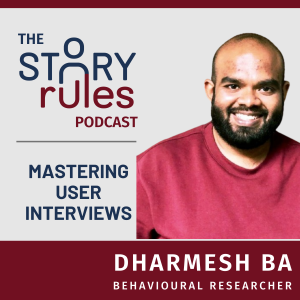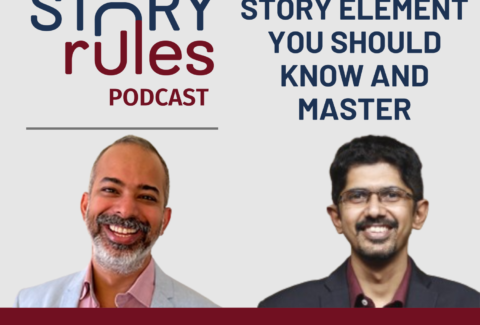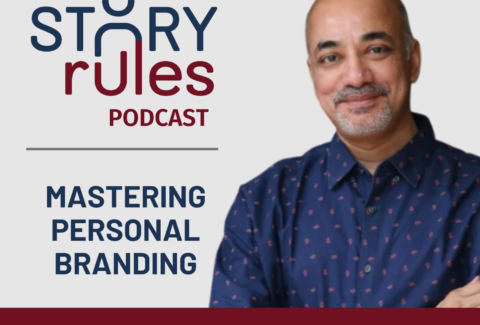Business Review Meetings suck. Here’s 10 Commandments to fix them

Business Review Meetings suck. Here’s 10 Commandments to fix them
“I’m really looking forward to the 2-hour business review presentation”
Said no one, ever.

Why do review meetings suck so bad?
And why does it bother me so much?
I’m a Storytelling coach. And in my workshops, I teach participants the techniques to convert detailed, complex data into simple, compelling stories.
But ever so often, when I suggest a new way of presenting information to a participant, I face resistance.
Here are two common examples:
Me: Your slide is too complex. You should split your messages across more slides – have only one message per slide
Participant: But I can’t do that
Me: Why…?
Participant: Because we have an internal restriction – any presentation should not exceed 10 slides…
Me: (Groan)
Or this second example:
Me: And that is how you can convert this boring data-table into this compelling story
Participant: That’s great. But our Client mandates us to present the information in that data-table template only
Me:

The core underlying problem here: trust. A deep lack of trust between the two key players involved in Data Review meetings: The Reviewer and The Storyteller.
Let’s understand where both of them are coming from.
The Reviewer: “I want the truth, but don’t trust the Presenter to give it”
In the Red Corner, we have ‘The Reviewer’. Typically senior leaders (or Clients). They want the Storytellers to present the “true picture” of the business as clearly and quickly as possible.
But they don’t trust the Presenter to do that, because they believe:
- Presenters usually hide bad news if any – especially if it reflects poorly on their performance or has any implication on their rewards
- Presenters tend to drown the Reviewer in an ocean of data – because of lack of their own clarity or worse, deliberate obfuscation
The Storyteller/Presenter: “I’d like to tell the truth, but worry about repercussions”
In the Blue Corner, we have The Presenter/Data-Storyteller. They want nothing else but an uneventful meeting. One in which The Reviewer doesn’t get into ‘Shoot-the-messenger’ mode, giving a tongue-lashing because the numbers don’t ‘satisfy them’…
One in which, perhaps they even get faint acknowledgement for the effort taken to simplify highly complex data …
Maybe even, gasp, a word of praise for the storytelling that enabled a better discussion and decision making…? Ah, who are we kidding…
And so it remains stuck in limbo.
Presenters are wary of trying something new for fear of incurring the Reviewers’ displeasure… And Reviewers prefer to drown in a sea of data, rather than trust their presenters to give them a clear, simple story.
The solution: 10 Commandments
As a solution, I propose a Satya-Vachan (Sacred-Oath) to be taken by folks on both sides of the table.
I call it the Ten Commandments of Business Review Meetings.
To keep it balanced, we’ll have 5 each – for the Storyteller and the Reviewer.
(Warning: This post is a bit of a rant. Ok, it is a full-on rant. Fasten your seat-belts, the ride’s gonna get bumpy!)
Here’s a quick summary.
Five Commandments for The Reviewer:
1. Thou shall insist on the Story and not the Data in all its vivid, gory detail
2. Thou shall approach the presentation as Mr. Curious or Ms. Learner; and not as Mr. Blame-Finder or Ms. Finger Pointer
3. Thou shall not be anal about presenting in standard templates, formats and dashboards
4. Thou shall let the presenter talk at least for the first 5 mins, without interruption
5. Thou shall refrain from mandating arbitrary rules like “No animations” or “5 slides only”
Five Commandments for The Storyteller:
6. Thou shall include every key element in a MECE manner, but thou shall not overwhelm thy audience in an ocean of data
7. If there’s bad news/poor performance, thou shall not hide it in slide 125
8. Thou shall not be a victim of the Curse of Knowledge
9. Thou shall make your story easy to understand visually
10. Thou shall create a script and rehearse before the meeting
All set? Let’s do this.
5 Commandments for The Reviewer:
1. Thou shall insist on the Story and not the Data in all its vivid, gory detail:
Sure, you pride yourself on your attention to detail. Sure, you remember the sales number for Product sub-category M5(a) in market Y from 3 years ago.
But before you go about insisting on seeing that data, ask yourself one question: Is it relevant? What is the key problem or issue you are trying to solve? And what are the key ‘big’ pieces of information you need to solve that problem?
And sure, if the sales figure of Product sub-category M5(a) in market Y from 3 years ago is critical to that question, please go ahead and dig-away.
But more likely it’s not. And so, refrain from being Mr. ‘Insist-On-Detail-For-The-Sake-Of-It’, and instead ask this magical four-word poser: “What’s the story here?”
Insist that the storyteller puts in the effort to understand the ‘essence’ of the data and extract the story in a MECE way. (Remind them of Commandment no. 6).
2. Thou shall approach the presentation as Mr. Curious or Ms. Learner; and not as Mr. Blame-Finder or Ms. Finger Pointer
Let’s face it. Review meetings will bring bad news. More often than you like. When said bad-news arrives, you have two options.
Option 1: Be Mr. Blame-Finder. I understand – you are worried about how you will communicate this bad news to your boss. You are experiencing a myriad of emotions: disappointment at the bad news, anger at the person or factor responsible, worry about how you will explain it higher up.
At such a time, it seems easy to have an emotional outburst at the Data-Storyteller.
But imagine what effect will this have on the Presenter. Anytime there’s some not-so-good news on the numbers, she will try her darn best to try and hide that information. Under a mountain of data. In font size 10. Preferably in the appendix.
How to avoid this? Simple, choose Option 2: instead of Ms. Finger Pointer, become Ms. Learner (or Mr. Curious).
The review presentation is not a Police Interrogation of a suspect. It is more like a joint diagnosis by a team of medical professionals – who’re trying to figure out what ails the business (and in which areas is it hale and hearty) … and what could be done to fix the issues…. so that you can jointly arrive at the next course of action.
This principle, by the way, is backed by research by Stanford – it’s called the use of Data for Learning and not for Inspection. You can read it in point 5 of the linked article. (Because, of course, we all need a stamp of approval from Stanford for common-sense advice).
3. Thou shall not be anal about presenting in standard templates, formats and dashboards
Sure, a template or a dashboard is useful for studying the data. But it’s not a story.
Here’s an analogy. Say the Storyteller is the Chef and the Reviewer is the diner at the restaurant.
Think of your data as the ingredients for the dish… and the template/dashboard as an interim stage in the cooking process. The stage when the chef has collected all the relevant ingredients and equipment (in the right measures) and laid it out ready to cook…
Imagine the chef calling the diner in at this stage to take a look and enjoy the dish…
You (the diner) would be like: “Hey, I don’t need curated list of ingredients – I need the prepared dish”
You don’t need a detailed template with information – you need the story.
By all means, use templates and dashboards for sharing information over email etc. But during review time, the template cannot become the story. Don’t insist on presenting using these tools.
4. Thou shall let the presenter talk at least for the first 5 mins, without interruption
The Presenter has worked for days (if not weeks) on the presentation. She’s put in her sweat, blood and tears, her very heart and soul.
Ok maybe not.
But surely, there’s a lot of effort gone into making the deck. The least you can do is give her the first five minutes (assuming the person isn’t saying blatant untruths or offensive stuff!) – so that she can summarise all the key findings.
But, but – what if a thousand questions pop into your mind? Questions that you’re afraid you’ll forget if the moment passes and you don’t ask immediately?
There’s a fascinating invention you may have heard of – it’s called (drumroll please): Pen and paper!!
(Ok that’s the last of ‘em snide remarks).
But seriously – five minutes. No interruptions.
After that – if you still find the storyteller meandering or being unclear – fire away the questions!
5. Thou shall refrain from mandating arbitrary rules like “No animations” or “5 slides only”
Once upon a time, in a darkened meeting room far, far away, a presenter did something abominable.
He (over)used animation.
Fed up with his insipid, complex presentation – and wanting to find a scapegoat – the leaders decreed:
‘THE USE OF ANIMATION IN THIS COMPANY’S SLIDES SHALL BE A PUNISHABLE OFFENSE. REPEAT OFFENDERS SHALL BE MADE TO VIEW THEIR OWN PRESENTATIONS ON LOOP.
WITH ANIMATION.’
Seriously, why all this drama for a simple, useful tool? Some over-use can be discouraged, but a blanket ban is counter-productive. Bring back the Animation I say!
Animation can be a useful tool to display the information on the slide in bite-sized pieces – and avoid overwhelming the audience with too much information. Let it be used.
Another classic counter-productive mandate: “Please restrict the presentation to 5 slides”.
You realise what you’re going to get right? The same 25 slides will now be compressed into 5. With a ton of information crammed into every slide. In font size 10 (being the maximum).
For your own eyes’ (and sanity’s) sake, do away with such restrictions.
Your only constraint is time.
Instead of restrictions on the number of slides, insist on the following:
- The Presenter to plan their story to finish within 67% of the allotted time (leaving 33% for Q&A)
- The Presenter to summarise all messages in the deck, into a simple 1-slide Executive Summary (at most 2 slides).
- Each slide to be simple, clear and meaningful and flow well from the previous slide
You’ll find that as long as each slide is easy to understand and the overall time constraint is met, the number of slides – Don’t. Matter. At. All.
That’s for the Reviewers. Now let’s move on to the Presenters.
Five Commandments for the Storyteller
6. Thou shall include all key elements in a MECE manner, but thou shall not overwhelm thy audience in an ocean of data
I get it. You have done a lot of work. And you’d like the audience to know that.
I mean who else creates 35 pivot tables from just one master table? And why should the audience be deprived of the unbridled joy, the unadulterated exuberance of your glorious analysis?
Because. Despite what you think, the audience is also human and deserves to live.
You may think they are here to marvel at your analysis, your numbers, your slides…
Surprise, surprise – the presentation is not about you!
You are just the guide to the audience, showing the torch-light, helping them make sense of the underlying problem/s in the business- and your recommended solution.
To do that, you must resist the temptation to simply dump the entire hot, steaming pile of data on the table….
And instead, think through what is the story. (For guidelines on how to do that, you can read this article).
As a storyteller, you have a responsibility not to overwhelm your audience with data. The same amount of effort that you expend in deciding what should go into the story, should be expended in deciding what stays out too.
But here’s the thing. Editing is not an excuse to exclude crucial parts of your story from the deck.
You need to run the ‘MECE’ test – are your presentation elements ‘mutually-exclusive and collectively exhaustive’? Do they cover all key elements in a ‘no-gaps’ and ‘no-overlaps’ way?
The ‘Collectively Exhaustive’ part especially is critical – to ensure comfort for the audience that nothing is missing.
Especially when it’s bad news…
7. If there’s bad news/poor performance, thou shall not hide it in slide 125
Uh oh. Product Q’s revenue was down 15% in the last quarter.
Down, huh? This means only one thing.
The management needs to be protected from the noxious effects of this piece of information.
Slide 125 in the Appendix it is.
Now, hiding bad news is a very high-risk strategy.
You may gain a few days of peace and quiet. But the moment you get caught (and you will get caught), you lose something far more important: your credibility.
As a result, when you present the next time (even if there’s nothing to hide), your seniors would suspiciously scour through your presentation – searching for that hidden bad news…
The better approach: be upfront about it. Depending on the impact of the bad news, state it clearly and unambiguously early enough in the presentation.
You can soften the blow by prefacing with something like: “Ok guys, you’re not going to like the sound of this, but…” OR, “The next part doesn’t make for happy listening…”
But the blow has to be delivered.
What’s more important, of course, are the two immediate next steps that must follow: The RCA (root cause analysis) and next steps.
RCA: Once the bad news has been given, immediately answer the question that will be foremost on the leaders’ minds: ‘Why did it happen’. Dive deep and identify the root-cause of the issue.
Next Steps: Then suggest your recommended corrective (and preventive) actions to ensure that the cause/s do not repeat again.
This 3 step approach (What – Why – Now What) is a simple way to build leaders’ trust in your story.
8. Thou shall not be a victim of the Curse of Knowledge
Hang on, knowledge is supposed to be a blessing right? How can it be a curse?
It can, when you forget that your audience doesn’t have it.
The Curse of Knowledge occurs when you assume that the audience knows as much as you do.
When you are so deeply entrenched in the details of the data, you forget what it is like, not to know the data. Essentially you fail to empathise with the audience.
And so, when you suddenly dive into explaining the nth level of detail of a specific factor (without giving the context that it was the reason for the fall in Product Q’s revenue), your audience is likely to give puzzled looks, asking “What gives?”
Leaders crave for context, for the big picture along with the details. Help them connect the dots.
Don’t fall prey to the Curse of Knowledge.
9. Thou shall make your story easy to understand visually
Vision trumps all our other senses – more than half of the cortex is devoted to visual processing.
When you are explaining something complex, here’s what happens:
- You understand the information very clearly – it’s like an image in your mind…
- …But you put it down on the slide in the form of gloriously verbose text
- Your audience struggles to convert the text to the clarifying image
- They either misunderstand the information or move on to other stuff – and the quality of decision making suffers
A simple remedy – try to recreate the image in your mind onto paper (or the slide). Not easy, but a worthwhile task.
While you are at it, you can explore these other proven storytelling techniques to make technical information easy to understand.
10. Thou shall create a script and rehearse before the meeting
A lot of us have a problem rehearsing. Typical excuses include:
“It’s my material – I know it cold!”
Sure you do. But this is a presentation, not a Q&A session. You need to know exactly what points you want to make (and not make!) on each slide – and more importantly how will you segue between slides. You need to create a script for each slide and for transitions. And practise it.
– “I did rehearse – I went through the slides and thought through what I’d say on each”.
That is not a rehearsal. You. Need. To. Say. It. Aloud.
And time yourself. You’ll identify parts where you are meandering; and parts where you abruptly jump from one section to another. Even minor tweaks to your script can then make a big difference.
– “I feel awkward rehearsing in front of a mirror”
You don’t need to! The best way to rehearse is in front of a live audience (face-to-face or virtual). Their reaction and body language will be the best guide for your delivery. If that’s not possible, record yourself presenting and go over the video. Sure you will cringe… but it’ll make you a better speaker.
Your audience deserves that better speaker. Make the effort for them.
——–
And that’s it – the Ten Commandments for Business Review Meetings.
Follow them and you’ll see a vast improvement in the quality of the discussion – and decision making – in your review meetings.
And what’s more, you might actually end up saying:
“I’m really looking forward to the 2-hour business review presentation!”
*****
If you would like such posts in your inbox, you can subscribe here!
Featured Image credit: Photo by André Ravazzi on Unsplash







